
Michael I was the ruler of the Polish–Lithuanian Commonwealth as King of Poland and Grand Duke of Lithuania from 29 September 1669 until his death in 1673.
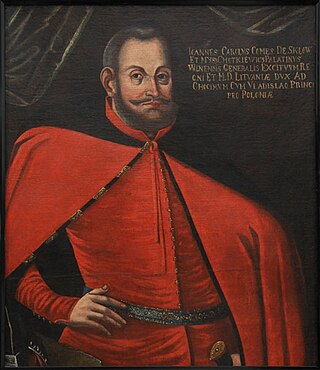
Jan Karol Chodkiewicz was a military commander of the Grand Ducal Lithuanian Army, who was from 1601 Field Hetman of Lithuania, and from 1605 Grand Hetman of Lithuania. He was one of the most prominent noblemen and military commanders of the Polish–Lithuanian Commonwealth of his era. His coat of arms was Chodkiewicz, as was his family name.

The Battle of Orsha, was a battle fought on 8 September 1514, between the allied forces of the Grand Duchy of Lithuania and the Crown of the Kingdom of Poland, under the command of Lithuanian Grand Hetman Konstanty Ostrogski; and the army of the Grand Duchy of Moscow under Konyushy Ivan Chelyadnin and Kniaz Mikhail Bulgakov-Golitsa. The Battle of Orsha was part of a long series of Muscovite–Lithuanian Wars conducted by Muscovite rulers striving to gather all the former Kievan Rus' lands under their rule.

Konstantyn Iwanowicz Ostrozky was a Ruthenian prince and magnate of the Grand Duchy of Lithuania and later a Grand Hetman of Lithuania from 11 September 1497 until his death.

Ostrogski is a Polish coat of arms of the Polish–Lithuanian Commonwealth. A variant of the Leliwa and Ogończyk coat of arms.

Korybut is a Polish coat of arms. It was used by the Princely House of Wiśniowiecki-Zbaraski and several branches of the House of Nieświcki in the times of the Polish–Lithuanian Commonwealth.

Stanisław Żółkiewski was a Polish nobleman of the Lubicz coat of arms, magnate, military commander and a chancellor of the Polish crown of the Polish–Lithuanian Commonwealth, who took part in many campaigns of the Commonwealth and on its southern and eastern borders. He occupied a number of high-ranking posts in the administration of the Commonwealth, including castellan of Lwów, voivod of the Kiev Voivodeship and Great Chancellor of the Crown. From 1588 he was also a Field Crown Hetman, and in 1618 was promoted to Grand Hetman of the Crown. During his military career he won major battles against Sweden, Muscovy, the Ottoman Empire and the Tatars.

The Battle of Cecora was a battle during the Polish–Ottoman War (1620–21) between the Polish–Lithuanian Commonwealth and Ottoman forces, fought from 17 September to 7 October 1620 in Moldavia, near the Prut River.
Mikołaj "Bearpaw" Potocki was a Polish nobleman, magnate and Field Crown Hetman of the Polish–Lithuanian Commonwealth from 1637 to 1646, Grand Hetman of the Crown from 1646 to 1651, governor of Bracław Voivodeship from 1636 and from 1646 Castellan of Kraków.
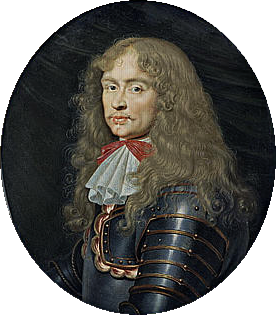
Bogusław Radziwiłł was a Polish princely magnate and a member of the Polish-Lithuanian szlachta, or nobility. He was of the Radziwiłł magnate family. By birth he was an Imperial Prince of the Holy Roman Empire. He was a descendant of the famous knight, Zawisza the Black. Following the death of Janusz Radziwiłł, he briefly served as Grand Hetman of Swedish Lithuania.

Prince Michał Serwacy Wiśniowiecki was a Lithuanian nobleman, magnate, politician, diplomat, general, a successful military commander and the last male representative of the Wiśniowiecki family.

Ivan Vyhovsky, a Ukrainian military and political figure and statesman, served as hetman of the Zaporizhian Host and of the Cossack Hetmanate for three years (1657–1659) during the Russo-Polish War (1654–1667). He succeeded the famous hetman and rebel leader Bohdan Khmelnytsky. His time as hetman was characterized by his generally pro-Polish policies, which led to his defeat by pro-Russian elements among the Cossacks.
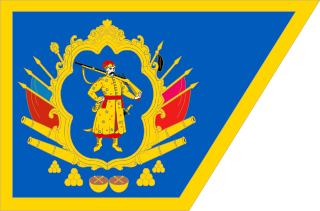
The Cossack Hetmanate, officially the Zaporizhian Host or Army of Zaporizhia, was a Cossack state located in central Ukraine. It existed between 1648 and 1764, although its administrative-judicial system persisted until 1782.

The House of Wiśniowiecki was a Polish-Lithuanian princely family of Ruthenian-Lithuanian origin, notable in the history of the Polish–Lithuanian Commonwealth. They were powerful magnates with estates predominantly in Ruthenia on lands of the Crown of the Kingdom of Poland, and they used the Polish coat of arms of Korybut.
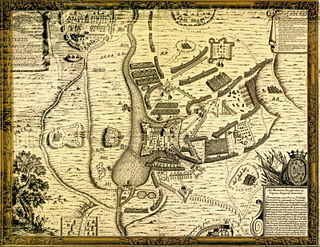
The Russo-Polish War of 1654–1667, also called the Thirteen Years' War and the First Northern War, was a major conflict between the Tsardom of Russia and the Polish–Lithuanian Commonwealth. Between 1655 and 1660, the Swedish invasion was also fought in the Polish–Lithuanian Commonwealth and so the period became known in Poland as "The Deluge" or Swedish Deluge.
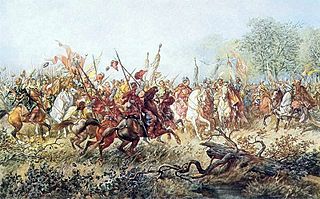
Battle of Korsuń, was the second significant battle of the Khmelnytsky Uprising. Near the site of the present-day city of Korsun-Shevchenkivskyi in central Ukraine, a numerically superior force of Cossacks and Crimean Tatars under the command of Hetman Bohdan Khmelnytsky and Tugay Bey attacked and defeated Polish–Lithuanian Commonwealth forces under the command of Hetmans Mikołaj Potocki and Marcin Kalinowski. As in the previous battle at Zhovti Vody, the outmanned Commonwealth forces took a defensive position, retreated, and were thoroughly routed by the opposing force.

The Battle of Kletsk was a battle fought on 5 August 1506 near Kletsk, between the Grand Ducal Lithuanian army, led by Court Marshal of Lithuania Michael Glinski, and the army of the Crimean Khanate, led by Fetih I Giray and Burnaş I Giray, sons of the Khan of Crimea, Meñli I Giray. The battle was one of the first and greatest Lithuanian victories over the Tatars.
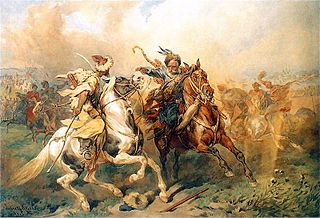
The Lipka rebellion was a mutiny from 1672 of several cavalry chorągwie (regiments) of Lipka Tatars, who had been serving in the forces of the Polish–Lithuanian Commonwealth since the 14th century. The immediate cause of the rebellion was overdue pay, although increasing restrictions on their established privileges and religious freedom also played a role.

The Battle of Podhajce was fought in the town of Podhajce in the Polish–Lithuanian Commonwealth, and the area surrounding it as part of the Polish-Tartar War and the Great Turkish War. The army of the Polish–Lithuanian Commonwealth under John III Sobieski, totaling around 9,000 men, defeated Tatar and Cossack forces under Petro Doroshenko and Adil Giray, which totaled around 35,000 men.
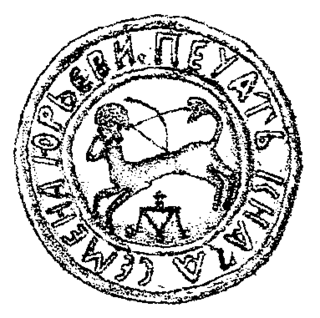
Prince Semyon Yurievich of Halshany was a noble from the Olshanski family in the Grand Duchy of Lithuania.


















